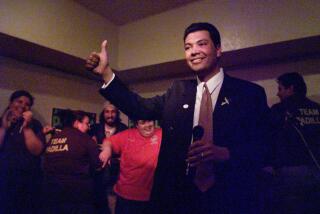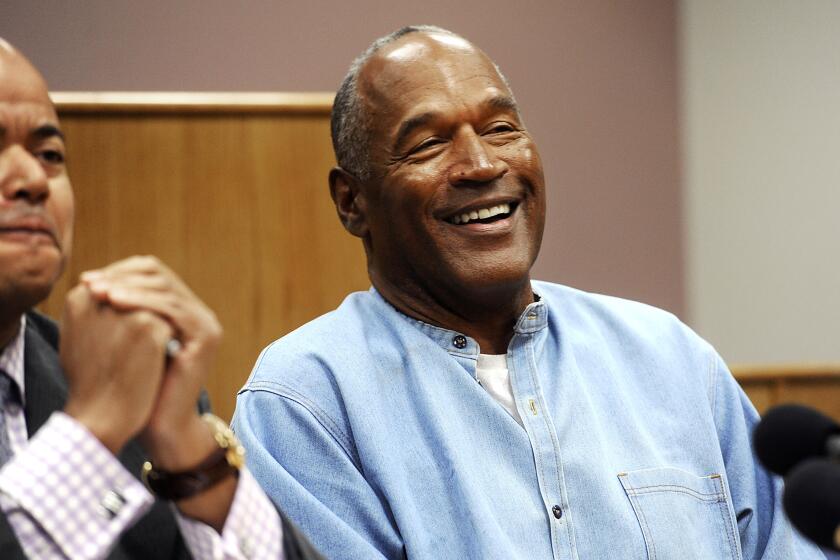Tubas become horns of plenty
Before he came to Southern California in 2002, Fidel Bernabe played trumpet in a small town in Mexico and believed himself to be very talented.
Los Angeles had many bandas — Mexican brass bands that play dance music at parties and nightclubs — that worked year-round. Surely there must be a band that could use his gifts, he thought.
But once here, he found competition intense. Bernabe rarely found two nights of trumpeting work and had to take a day job in a sewing factory.
“You come to get out of the hole,” he said. “You think you’re going to grab money in piles. You get here and you realize it’s not as easy as you imagined.”
Then, by accident, Bernabe found the tuba. He saw a deal for one in L.A. and bought it for his brother, a tuba player in Chicago. When his brother couldn’t pay, Bernabe kept the instrument and decided to learn it on his own. For more than a year, he practiced for hours after his sewing job.
Tubas were in growing demand. By 2007, he was playing five gigs a week — sometimes two a night. He found all that he’d imagined in America. He quit his job, got married, had three kids and supported them with his tuba.
“The tuba has radically changed my life,” he said.
::
Bernabe is part of what he and other banda musicians are calling Southern California’s “tuba revolution.” The mania for the instrument arrived from Mexico several years ago and is fueled by the large number of house parties that occur here every weekend. Immigrants who once were too poor to hold such parties in their homeland now view a tuba-equipped banda as a sign of having arrived.
Tuba players say partygoers now throw wadded dollar bills into their instruments — sometimes so many that they clog the pipes.
“We have millions of people in Southern California of Mexican origin,” said Jesse Tucker, a banda tuba player in Pomona. “They all throw parties. They all have quinceaneras; they all get married. And every group can use a tuba.”
At one of these parties recently, on a patio outside a modest stucco house in Huntington Park, guys with gold bracelets and black dress shirts and girls with too-tight miniskirts danced to the tuba-driven polka beat of Tucker’s trio, Los Hermanos Carrillo con Chikilin y su Tuba. To the side, a woman cooked carne asada on a propane grill.
Tucker, who stands 6 feet 4, gyrated and blasted his horn into the ears of dancers, sounding as fast as a heavy-metal guitarist and as wild as a free-jazz man.
Watching it all was Jesse Chavez, hosting his own 25th birthday party that night. Chavez said the success of his party was dependent on a tuba, which has a reputation for attracting dance-minded partygoers — especially women, he added.
“I had to have a tuba,” he said. “There’s more thunk, thunk. Also, they bring girls.”
These days, clients won’t hire a band “if you don’t have a tuba,” Jose Davila, singer and accordionist for the norteno band Grupo 5.7, said between sets at another backyard birthday, this one in South Los Angeles. Norteno groups almost always use bass players, but Grupo 5.7 fired its bassist and replaced him with a tubist to keep partygoers happy.
This newfound popularity and economic power has unleashed a kind of liberation movement among Southern California banda tuba players.
No longer forced to the back of the banda, tuba players are out front, standing next to singers, leading lines through parties. They are showing their chops with wild improvisation while keeping time and bass to traditional three-chord Mexican songs.
“We were in a little box before. Now they’ve set us free and we’re able to show what we’re capable of,” said Santiago “Shagi” Mata, a tubist who lives in Maywood. “Now the girls want us to play near them and take photos with us.”
::
When it comes to inspiration, the Los Angeles area has long served as muse to the tuba player.
Disneyland, movie studios and schools with large marching bands have provided formally trained tuba players with work and teaching opportunities and created a vibrant tuba scene in Southern California.
“L.A. is the tuba capital of the world and has been for many years,” said Bill Roper, a jazz tubist in Altadena.
Two players, in particular, made it that way. Tommy Johnson, a tuba professor at USC who died in 2006, almost single-handedly populated the tuba world with his students and played on more than 2,000 movie soundtracks, including the shark music on “Jaws.” (Three top tubist jobs in America — at the New York, Chicago and Los Angeles symphonies — are filled by students of Johnson.) Roger Bobo, who now teaches in Japan, was a tubist with the Los Angeles Philharmonic for 25 years and made solo recordings that expanded the instrument’s role, said Gene Pokorny, a tubist with the Chicago Symphony Orchestra.
“What they managed to put together in Los Angeles busted the bar of expectations of what the tuba could do everywhere in the world,” said Pokorny, who studied with Johnson and listened fervently to Bobo’s recordings.
Competition, their legacy and the variety of jobs available made classically trained tubists here adaptable. “You have to invent yourself,” said John Noreyko, a jazz tubist who plays at Disneyland. “If you really want to play, you have to be very tenacious and come up with something that someone’s not doing.”
This attitude has just begun to permeate the Mexican tuba world in Southern California. In fact, the formally trained tuba players and banda players rarely meet. While classical tuba players learn to read music and are mentored by instructors, banda players are self-taught, and few can read music. For years, in their tradition-bound genre, banda tubists were limited to less than two octaves, huffing and puffing in anonymity.
Other musicians “would get mad at you if you played a lot of complicated stuff. They’d tell you, ‘Just keep it simple,’ ” said Juan Damian, a tuba player in Moreno Valley.
But that changed in 1997 in Mexico, when Banda Los Tierra Blanca recorded a classic song, “Mi Gusto Es,” with a young musician on tuba named Alfredo Herrejon.
Herrejon, a trumpeter by training, didn’t follow the plodding bass line that traditional songs required. Instead, he fluidly crammed notes into the song and soared between octaves.
“Maybe it was something people hadn’t heard before,” Herrejon said. “It doesn’t have anything otherworldly about it, but for that time it was something different.”
The song electrified Mexican tuba players; Herrejon was dubbed El Rey — The King. “It was a revelation,” said Rigoberto Santos, a tubist from Mexico who recently moved to the San Fernando Valley. “Every tuba player began copying him.”
Around this time, Carlos “El Jokoqui” (“Sour Cream”) Soto, the tuba player for Banda El Recodo, raised the bell of his tuba. Previously, the sousaphone tuba’s bell covered half the player’s face. Some older tubas, containing too much copper, stained the player’s forehead green. Soto’s design was copied by others. Now players could see and be seen as they demonstrated their chops with wild improvisation.
Gradually, this style of playing found its way to Los Angeles, and the instrument’s popularity took hold.
::
Jesse Tucker, also known as “Chikilin” or “Tiny,” said it’s about time. He had long been upset that banda tuba players carried the heaviest, most expensive horns, played virtually nonstop and anchored the band, yet were paid the same as other musicians.
In 2007, as demand for tubas was beginning to grow, Tucker persuaded half a dozen of the region’s best banda players to insist on $80 an hour, up from $50.
“A lot of band leaders didn’t like it,” he said. But they paid it. Banda tuba players now earn more than $100 an hour.
With wages like that, players began leaving their groups to freelance because they can get more gigs. Playing with different bandas enriched them as musicians, raising the talent bar.
Musicians formed new groups. More groups meant more tuba players were needed. The latest popular style, known as Sierreno, uses a tuba with guitars and accordions.
::
Today, the thunder of banda tuba experimentation peals across Southern California, with players using hip-hop, country, scratching, jazz and electric bass lines as they reinvent a Mexican folk music far from home. As a sign of how tradition-bound Mexican tuba was for years, it’s considered bold that some tubists now play in minor keys.
Fidel Bernabe meets tuba players all the time now; many have switched from saxophone, trombone or, like him, trumpet.
He sees tubists practicing harder and competition getting fiercer. But the jobs are still there.
“Of every 10 calls I get, eight are offering work,” he said. “I’m thankful to God for whatever talent I have on the tuba.”
More to Read
Start your day right
Sign up for Essential California for news, features and recommendations from the L.A. Times and beyond in your inbox six days a week.
You may occasionally receive promotional content from the Los Angeles Times.






